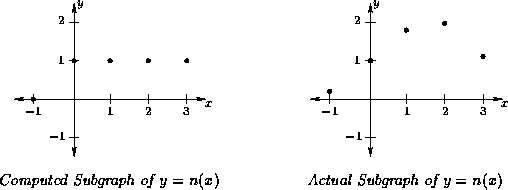




Next: 1.5 Computability
Up: 1 Motivation
Previous: 1.3 Relations
Given that a basic algorithm has failed us, it is reasonable to
do a survey of our basic tools.
We are most interested in finding a graphing algorithm which
we may program a modern computer to perform.
One immediate concern is the representation such
machines use for real numbers.
The representation often used is analagous to scientific notation,
keeping a fixed number of digits for any given quantity.
This can lead to further difficulties.
Consider graphing the equation
by sampling n(x),
limiting ourselves to three digits of precision.
A transcription of the computations performed,
while sampling n(x) at x = -1,0,1,2, and 3
follows:
It is clear that for all x, our computations result
in  or
or  , due to numerical round-off.
It is equally clear that
so that
, due to numerical round-off.
It is equally clear that
so that  .
Most calculations introduce some numerical round-off.
With complicated equations, there will be long sequences of calculations,
which allows numerical round-off to accumulate.
For such equations,
the generated graph may differ significantly from the actual graph.
.
Most calculations introduce some numerical round-off.
With complicated equations, there will be long sequences of calculations,
which allows numerical round-off to accumulate.
For such equations,
the generated graph may differ significantly from the actual graph.





Next: 1.5 Computability
Up: 1 Motivation
Previous: 1.3 Relations
![]()
![]()

![]()
